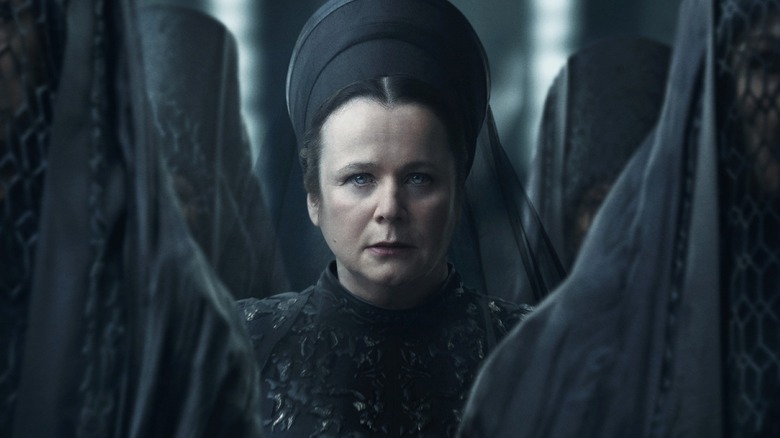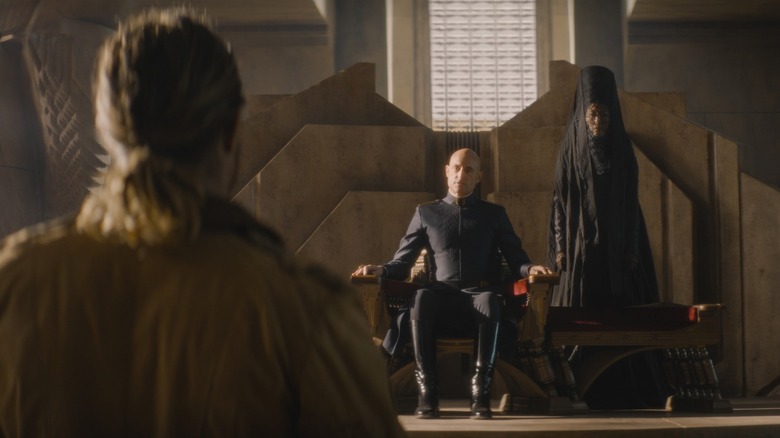One Piece Of Sci-Fi Tech Directly Connects Dune: Prophecy To The Movies
Just when you thought the world of "Dune" couldn't possibly get any bigger or more epic, HBO has decided to bring the sci-fi franchise to the small screen with "Dune: Prophecy" — not with another sequel, but through a prequel series set in the same continuity as director Denis Villeneuve's two movies. Set 10 thousand years before Timothée Chalamet's Paul Atreides became the "hero" of Arrakis and took on the might of the entire Imperium, the spinoff will instead focus on the sect of all-knowing space witches referred to as the Bene Gesserit. Their primary function, you'll recall, has been the manipulation of genetic family trees in a never-ending quest to produce the Kwisatz Haderach, the chosen one figurehead prophesied in eons past to represent the next step of human evolution. (That's the CliffsNotes version, at least. Readers know that "Dune" author Frank Herbert was never one to simplify his own world-building.)
With all sorts of time and space to tell a new story, viewers can look forward to a fresh and unexpected take on the universe that's nothing like what we've seen before ... with one key exception. As much as things may be different, "Dune: Prophecy" will still directly connect with the big-budget blockbusters that audiences worldwide have come to embrace. That was a major point of emphasis by the creative team during a recent press event attended by /Film. The devil will be in the details, apparently, courtesy of a certain piece of sci-fi tech that fans ought to be able to instantly recognize.
Dune: Prophecy will include 'Holtzman' technology from the movies
How do you tell a brand-new story in a franchise relying on famous movie stars and familiar iconography, all while still providing enough connective tissue with what came before? While speaking at a press event with /Film in attendance, "Dune: Prophecy" executive producer Jordan Goldberg described the new tale as a "period piece in the future" (a reference to the prequel setting taking place long before the movies, yet far in the future beyond our present day). That said, it'll still bear some recognizable hallmarks for fans of the "Dune" movies. Much of it comes down to a niche bit of lore known as "Holtzman" tech, named after the in-universe physicist whose scientific breakthrough paved the way for the fancy shield technology, gravity suspensors (like the one used by the villainous Baron Harkonnen), and faster-than-light spaceship engines glimpsed throughout the films. According to Goldberg:
"For us, when you take something like the Holtzman technology, the Holtzman shields and stuff like that, I think it's fun to play with that because it is a really cool device in the films and in the books. And so it's cool to have that in our world. And what we did with it was extend it to other things. Our hover crafts are Holtzman-generated. We have a prison where people are levitated with Holtzman belts. We've got wheelchairs that are Holtzman-levitated, as well. So it's just fun to take some of the staples in terms of technology and just extend it and try to show how it's sort of spread out through our universe."
Based on the 2012 novel "Sisterhood of Dune," written by Frank Herbert's son Brian Herbert and Kevin J. Anderson, "Dune: Prophecy" is clearly staying faithful to the world as imagined by Herbert and adapted by Villeneuve. But the challenge of blending those styles with another unique approach was something that showrunner Alison Schapker made sure to give plenty of careful consideration.
Dune: Prophecy will visit planets never seen in the movies
HBO recently had to figure out how to expand the world of "Game of Thrones" with the prequel series "House of the Dragon," while rival Prime Video faced a similar (and arguably more complicated) issue when it came to defining the look and feel of "The Lord of the Rings: The Rings of Power" compared to the world-famous Peter Jackson movies. Now, it's "Dune: Prophecy" that finds itself navigating the same waters. The Denis Villeneuve "Dune" films made an instant impression on the strength of their visuals alone (with a crucial assist from cinematographer Greig Fraser, who also was behind the camera on "The Batman"), raising a very high bar for the prequel series to match. To hear Alison Schapker tell it, it was all about following in the footsteps of the two recent movies ... to a certain extent:
"We were definitely influenced by, obviously, the films and Denis Villeneuve's universe that he set up. I think he really unlocked 'Dune' for people and keeping it an incredible spectacle, but also really feeling grounded in the characters. Yes, we do view ourselves as 10,000 years earlier, but speaking to those films from a distance."
That applies both metaphorically and literally, as it turns out, because "Dune: Prophecy" will avoid the temptation of turning the desert world of Arrakis into their own version of Tatooine — the planet that almost every "Star Wars" story seems compelled to return. Schapker went on to explain:
"I think that, though, one of the ways that really helped us distinguish ourselves is that we're not really set on Arrakis. While Arrakis exerts a pull in the Imperium, like it does in any 'Dune' story, it's at a distance. It's haunting us from afar. It's influencing events from afar. We were able to set our story on worlds that, hopefully, will be fun for 'Dune' fans who enjoyed the movies to go to different planets that they haven't been before."
She specifically name-dropped planets like Salusa Secundus and Lankiveil while teasing many more to come, showing off just how nerdy this series is about to get. We'll find out for ourselves when "Dune: Prophecy" hits HBO and Max on Sunday, November 17, 2024.


